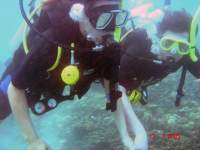Dear Beast Crew
September – December 2005
G’day from down under! We have been on the road for just over a year now and it is shrimps on the barbie time down here with temperatures soaring to a warm 30 degrees in Melbourne and a warm 35 degrees in Sydney.
As Christmas is fast approaching we would appreciate it if Father Christmas could squeeze a Beast product into his Christmas Stocking. Just go to our webpage and click on charities. You can either make a donation or chose one of our fabulous products just by clicking and buying the product or go to this link BEASTLY SHOP all profit will go to our charities.
Anyway, the adventure continues….
Melbourne – Snowy Mountains – Phillip Island – Melbourne – Darwin – Kakadu – Alice Springs – Uluru (Ayre’s Rock) – Coober Pedy – Port Germein – Adelaide – Kangaroo Island – Port Fairy – Great Ocean Road – Melbourne
Greg’s friend Jean Christophe travelled from France to spend a few weeks with Alexis and Greg so it was decided that we would see a bit more of Australia and travel to the red centre.
We started our adventure with a trip into the not
 so Snowy Mountains in northern Victoria/Southern New South Wales, first stopping off for the Wangaratta Jazz Festival. We spent a few days in Kosciuszko National parks watching wet kangaroos and wombats wonder around in the mountain drizzle. The snow season in the Snowy Mountains is from July through to September and the depth of snow can get as thick as 3.5m but is usually a few centimetres. Unfortunately we were there in the snow melt and drizzly rain. The highest mountain in Australia is Mount Kosciuszko at a mere 2228m.
so Snowy Mountains in northern Victoria/Southern New South Wales, first stopping off for the Wangaratta Jazz Festival. We spent a few days in Kosciuszko National parks watching wet kangaroos and wombats wonder around in the mountain drizzle. The snow season in the Snowy Mountains is from July through to September and the depth of snow can get as thick as 3.5m but is usually a few centimetres. Unfortunately we were there in the snow melt and drizzly rain. The highest mountain in Australia is Mount Kosciuszko at a mere 2228m.On the way back from the Snowy Mountains we popped into Phillip Island. Phillip Island is located at the bottom of Port Phillip Bay (Melbourne is at the top) and the island is famous for its daily penguin parade. They are the smallest penguins in the world at a mere 33cm. The beautiful little or fairy penguins troop out of the sea and run/waddle up the beach to their burrows in the sand after a busy day hunting fish offshore. It is slightly staged with a massive stadium set up on the shore with big lights shining onto the beach, but as with conservation across the world it seems to be the only to make people understand the animals they are watching in order to preserve them.
The following day the three of us flew up to Darwin to drive down and see the red centre. We gave the Beast a rest as she would have been too hot in the 40 degree heat and we only had 10 days holiday! So we picked up a Mini Beast or in honour of our French travelling partner, the Petit Beast – a camper Toyota Hiace. We got back on the road and headed down the Stuart Highway.
The Stuart Highway slices Australia in half like a black ribbon, from Darwin in the north, it roams 2,690 kilometres (1,671 miles) to Adelaide in the south. It is also known as the Explorer Highway and is named after an adventurous Scot, John McDouall Stuart. He led expeditions through Southern Australia and the Northern Territory on a quest to establish a permanent route north from Adelaide to Darwin. He finally achieved his ambition in 1863. The road was only sealed (tarmaced) in 1987, allowing 2 wheel drive cars to transect the continent.
We took a diversion to the world heritage site of Kakadu – one of the only places on the planet to have accreditation for cultural and natural factors. The roads are lined by the living termite motels, some that can reach over 6m high and 50 years in age. The park is home to thousands of birds, animals, mosquitoes and annoying bush flies. Kakadu is named after the Gugudju people who live in the park. There are over 60 types of marsupial, 280 species of bird, 117 species of reptile, 1,700 species of plants and over 10,000 species of insects. An amazing place that we watched fantastic lightning from our campsite swimming pool and then got up at 6am to see the early morning crocodiles and birds patrolling the waterways, then on to the unbelievable Nourlangie where the rock paintings date back to 20,000 years ago. Some of the paintings even show skeletons of the kangaroos.
We headed back to the Stuart Highway and down through Katherine, Daly Waters and Tennant’s Creek. The temperatures were unbearable outside of the air conditioned Petit Beast due to the “build-up” just before the wet season that pushes humidity up and temperatures creep towards 40 degrees. The common complaint from people from Tennant’s Creek to Uluru was that over the past 7 years they have experienced more humidity and more rain; a sign of the changing environment through global warming.
We stopped off at the Devil’s Marbles that lurk just off the highway, a pile of massive boulders precariously balanced on top of each other, up to 6m in diameter, slowly being weathered away located in the middle of a desert. They form part of the local dream time of the aborigines and are thought to be the eggs of the rainbow serpent. We stopped to fill up with petrol in Wycliffe Well to be confronted with two fenced in aliens next to the forecourt. Apparently Wycliffe Well has been the centre of UFO activity since the 1940s. We crossed over the Tropic of Capricorn and headed south to Alice Springs.
Alice Springs is well known as the stopping point before Uluru and for its large aboriginal population who sit around. Aborigines are still misunderstood and persecuted by the white population of Central Australia. Slowly the land is being handed back the aborigines who understand and maintain the land in accordance with their 60,000 years of knowledge. Within the aboriginal population there are issues with alcohol abuse and the new boredom relief is to sniff petrol leading to the introduction of petrol in the Northern Territory and Western Australia of an odourless petrol.
We stopped off at the Henbury Meteorite site where a massive meteorite split into 12 and pummelled the earth creating massive craters and then headed off the Stuart Highway past the impressive Mount Connor to a red Uluru surrounded by greenery.
 Uluru, formerly named Ayers Rock, is a massive monolithic sandstone rock with a high iron content. We arrived at the rock just in time to line up with the other cars and watch the amazing sunset as it changed colour and merged into the purple sky. We met the London to Sydney rally, 15 classic British cars racing to Sydney in 3 months. It covers an area of 3.3 square kilometres and is 9.4 kilometres around its base. It rises 345 metres above the plains and is believed to extend several kilometres below the surface. We went to the campsite for the evening and sat and had a barbeque surrounded by solar system. Wild dingoes started to circle and one stopped to growl at us for the sausage sandwich in hand. He was only discouraged from his mission by a viscous growl in return from Greg. The following day we got up at 5am to watch the rock change colours again as the sun rose. Jean Christophe decide to climb the Rock (it takes a mere 1.5 hours) whilst Alexis opted to do the rangers walk around the base and not risk joining the other 37 people who have died falling off the rock in the past 20 years. The rangers walk provided an interesting insight into the cultural heritage of the rock that is sacred to more than 5 different groups and used as a place of worship.
Uluru, formerly named Ayers Rock, is a massive monolithic sandstone rock with a high iron content. We arrived at the rock just in time to line up with the other cars and watch the amazing sunset as it changed colour and merged into the purple sky. We met the London to Sydney rally, 15 classic British cars racing to Sydney in 3 months. It covers an area of 3.3 square kilometres and is 9.4 kilometres around its base. It rises 345 metres above the plains and is believed to extend several kilometres below the surface. We went to the campsite for the evening and sat and had a barbeque surrounded by solar system. Wild dingoes started to circle and one stopped to growl at us for the sausage sandwich in hand. He was only discouraged from his mission by a viscous growl in return from Greg. The following day we got up at 5am to watch the rock change colours again as the sun rose. Jean Christophe decide to climb the Rock (it takes a mere 1.5 hours) whilst Alexis opted to do the rangers walk around the base and not risk joining the other 37 people who have died falling off the rock in the past 20 years. The rangers walk provided an interesting insight into the cultural heritage of the rock that is sacred to more than 5 different groups and used as a place of worship. We drove south across the hot, barren desert that shimmered along the horizon. Road trains materialised out of the water-like road surfaces. We stopped at the interesting desert town of Coober Pedy. The name Coober Pedy actually means “White man’s burrow” and refers to the locals habit of excavating the baked earth and heading underground to the cool multi coloured rocks. The temperatures in the town can rocket up to boiling 52 degrees. We stayed in the Desert Cave Hotel where the rooms are carved into mounds of soil that show the wonderful pink striations in the cream rock. Now you maybe asking why people would want to live in such an inhospitable environment. The reason is because opals were discovered in Coober Pedy causing a rush for these beautiful azure gems. Australia supplies 90% of the world’s opals so it is a valuable commodity. We visited the opal caves, the underground shopping centres and the underground churches, before travelling out to the dingo fence located just 15km outside of Coober Pedy. The fence was created between 1880 and 1885 when the dingoes were attacking and eating the sheep of the southern states. It stretches for a total of 8,500km from the Queensland coast down to Western Australia. It is the longest man made structure in the world.
We headed south past the Flinders Range, stopping in the beautiful Port Germain (home of the southern hemisphere’s longest wooden jetty and one of the best pubs in Australia), having a quick look around Adelaide and then to Kangaroo Island. Kangaroo Island has been voted the world’s best natural paradise. Kangaroos, echidnas, wombats and giant goannas all wander around this beautiful paradise. The island boasts a huge Fur seal population as well as wonderful beaches and the remarkable rocks.
Our visit to Kangaroo Island was a short one as we headed back to Melbourne. Our journey was temporarily interrupted as we were pulled over by a policeman as Jean Christophe hit 125km/h (25km/h over the speed limit instantly means you loose your license in Victoria). The policeman dropped the charge to 123km/h and insisted on showing his 5.7 litre engine to prove how he managed to get up to 230km/h to catch us! Our journey ended with a drive along the Great Ocean Road, one of the world’s top 10 best drives with stunning coves and rock formations including the Twelve Apostles (only 8 that remain!) and back to Melbourne.
From Adriano, Alexis and Greg at the Beastly Adventure, we hope you have a fantastic Christmas and thank you for your continued interest and support! Watch out for our articles in the Offroader and in Land Rover Monthly and if you are in Australia hopefully you will see Alexis and Greg winning $200,000 on television!
Notes about Australia
- Some good Aussie words to throw into your next Christmas party conversation – Hoon – a hooligan, Bogan – a country person, kev, Dingle - a dent, Long grass people – drunks who shout but can’t be seen, Chunder – throw up, Arvo – afternoon, Smoko – smoke or coffee break, Servo - service station, Grey Nomad – pensioners that spend their lives roaming the road, Pom, Pommy or Pommy Bastard – an Englishman, Wog – used for someone of Mediterranean decent (not offensive), Fair Dinkum – true, genuine and Greg’s personal favourite, Shithouse – something unenjoyable, bad, poor quality.
- Burger King is known as Hungry Jacks in Australia.
- The ozone hole is presently sitting over southern Australia so the burn time is about 15 minutes and skin cancer rates have rocketed.
- You can be fined $55,000 for feeding a dingo.
- You can be fined just $5,000 for walking on a sacred Aboriginal site.
- Uluru is sacred to more than 5 different aboriginal groups and is used for ceremonies. Ceremonies are started by 2 of the elders climbing the Rock to put a wooden stick into the rock. The track that the elders climb in sacred but it is also the route that tourists now climb. The aboriginals plead with people to not climb the rock as they take it as a personal loss if someone is injured or dies.
- A total of 37 people have died falling off the Rock since the 1985. Many more have been hospitalised from heat stroke.
- Ownership of Ayre’s rock and surrounding land was only handed back to the traditional owners in the 1980s.
- The geology of the rock is Arco sandstone which actually has iron ore basalt and granite as its constituents.
- There are aboriginal fables relating to the Rock that state that two of the Seven Sisters (in the stars) were resting after being chased by Orion and told their two sons to go and play. Their sons went and played in the mud and created Mount Connor and Uluru.
- The desert spade foot (a frog) uses the ponds created at the base of Uluru after rain to spawn their tadpoles. They created a mucus bubble full of water and can lay dormant underground for up to 20 years.
- Australia has 8,222 islands around its coast.
- Australia is the lowest continent in the world with an average elevation of 330 metres.
- Between about 55 and 10 million years ago Australia drifted across the surface of the earth as a plate, moving north from a position once adjacent to Antarctica.
- Apart from Antarctica, Australia is the driest continent in the world. About 35% of the continent receives so little rain, that it is classified as desert.
- In June 2001, the Aboriginal and Torres Strait Islander population of Australia was estimated to be 458,520, or 2.4% of the total population.
- According to the Australian Statistics organisation, hospitalisations attributed to ‘assault’ are at a rate 8 times higher for aboriginal males and 28 times higher for aboriginal females, compared with non-aboriginal males and females respectively.
Posted by Alexis
at 12:01 AM GMT
Updated: Saturday, 11 February 2006 2:58 AM GMT
Permalink | Share This Post
Updated: Saturday, 11 February 2006 2:58 AM GMT
Permalink | Share This Post



 club for Victoria about our trip. A visit to Glenrowan in Victoria allowed us to get an insight into the best known Australian outlaw, Ned Kelly, a bank robber who ransacked banks and murdered police across southern Australia. He was hanged in 1880 after a shoot out against the police, dressed in some homemade armour. Plans are afoot to go skiing in the Snowy Mountains and to take a trip through the red centre to Uluru (Ayres Rock).
club for Victoria about our trip. A visit to Glenrowan in Victoria allowed us to get an insight into the best known Australian outlaw, Ned Kelly, a bank robber who ransacked banks and murdered police across southern Australia. He was hanged in 1880 after a shoot out against the police, dressed in some homemade armour. Plans are afoot to go skiing in the Snowy Mountains and to take a trip through the red centre to Uluru (Ayres Rock). 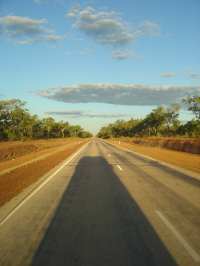 So we set off from Darwin with the sole aim of reaching Daly Waters for Alexis?s 29th birthday. We stocked up with water, food and petrol and started along the stunning Stuart Highway south. The sky was a brilliant blue with a few scattered clouds streaming across it, the pale green and white of the eucalyptus trees and the red soil of the outback were exactly what we were expecting but the colours were not ? they were so brilliant in strength. Due to the heat of the day there were many forest fires along the road. One particularly bad one we stopped to have a look at. It was rampaging along the side of the road, birds were running out, insects scurrying across the road and lizards darting away from the heat our whilst the kites circled above waiting to scavenge out the unfortunate cooked ones. A sad situation but when careless people throw cigarettes out the window it all becomes kindling wood. The fire brigade were out trying to stop other fires from spreading by controlled burning around the fires. Bill Bryson had written about Daly Waters in his book Down Under and so we had to visit it too. We reached Daly Waters after a 8 hour drive in a car that is lucky to stay under 40 oC, sweaty and hungry. We made straight for the bar! The Daly Waters Pub is something to be seen to be believed. Situated right next to the camp site, this backwater pub is the centre of the town and adorned with everything and notes from across the world. The walls are coated in t shirts, pictures, badges, stickers, signs, old agricultural machinery, the compulsory knickers and now a Beastly Adventure card. Dinner consisted of a pasty due to the kitchens being closed followed with an ice cold beer and a bottle of Aussie champagne! No better way to celebrate your birthday!
So we set off from Darwin with the sole aim of reaching Daly Waters for Alexis?s 29th birthday. We stocked up with water, food and petrol and started along the stunning Stuart Highway south. The sky was a brilliant blue with a few scattered clouds streaming across it, the pale green and white of the eucalyptus trees and the red soil of the outback were exactly what we were expecting but the colours were not ? they were so brilliant in strength. Due to the heat of the day there were many forest fires along the road. One particularly bad one we stopped to have a look at. It was rampaging along the side of the road, birds were running out, insects scurrying across the road and lizards darting away from the heat our whilst the kites circled above waiting to scavenge out the unfortunate cooked ones. A sad situation but when careless people throw cigarettes out the window it all becomes kindling wood. The fire brigade were out trying to stop other fires from spreading by controlled burning around the fires. Bill Bryson had written about Daly Waters in his book Down Under and so we had to visit it too. We reached Daly Waters after a 8 hour drive in a car that is lucky to stay under 40 oC, sweaty and hungry. We made straight for the bar! The Daly Waters Pub is something to be seen to be believed. Situated right next to the camp site, this backwater pub is the centre of the town and adorned with everything and notes from across the world. The walls are coated in t shirts, pictures, badges, stickers, signs, old agricultural machinery, the compulsory knickers and now a Beastly Adventure card. Dinner consisted of a pasty due to the kitchens being closed followed with an ice cold beer and a bottle of Aussie champagne! No better way to celebrate your birthday!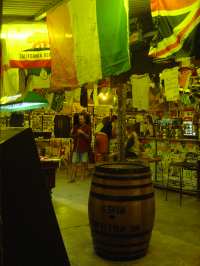
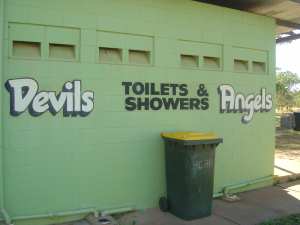 outback fun. Hell?s Gate was named after a gap in the hills located 2km south where the police used to escort settlers and aborigines into the jurisdiction of the Northern Territory Police, a mere 200km away. If you were escorted to Hell?s Gate it was a death sentence. Hell?s Gate now has a camp site, a station (farm), a restaurant and runway. The runway is used by the station and surrounding stations for refuelling before zooming off to round up cattle over the million plus hectares that some of the farms cover.
outback fun. Hell?s Gate was named after a gap in the hills located 2km south where the police used to escort settlers and aborigines into the jurisdiction of the Northern Territory Police, a mere 200km away. If you were escorted to Hell?s Gate it was a death sentence. Hell?s Gate now has a camp site, a station (farm), a restaurant and runway. The runway is used by the station and surrounding stations for refuelling before zooming off to round up cattle over the million plus hectares that some of the farms cover.  We experienced our first proper rain since Europe (Malaysia was quick rainstorms) as we dropped down onto the western ?Sunshine Coast?. We stopped at Inisfail before working our way down to Townsville where we met Sharon and Ken who fed a 100 strong troupe of Rainbow Lorikeets who would descend every day for their treat of sugar, bread and water.
We experienced our first proper rain since Europe (Malaysia was quick rainstorms) as we dropped down onto the western ?Sunshine Coast?. We stopped at Inisfail before working our way down to Townsville where we met Sharon and Ken who fed a 100 strong troupe of Rainbow Lorikeets who would descend every day for their treat of sugar, bread and water.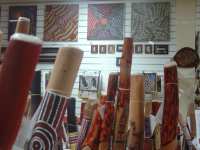 100,000 people which drops by 15,000 people in the wet season as people head towards the sun and a drier atmosphere. Temperatures in the wet season soar and the atmosphere gets very sticky. Darwin has suffered badly over the past since it was established in 1869. The Japanese carried out mass bombings of Darwin in 1942 and over 30,000 people were evacuated from the city. When Cyclone Tracy hit in 1973 it completely wiped out most of the buildings in the town, leaving a new ?70s town in its place with faceless grey and white buildings. The World War II air raid shelters and tunnels are still in place and can be visited but Greg and Alexis indulged themselves in the Deckchair Cinema, an open air cinema, looking out onto the bay and lounging on deckchairs you can enjoy
100,000 people which drops by 15,000 people in the wet season as people head towards the sun and a drier atmosphere. Temperatures in the wet season soar and the atmosphere gets very sticky. Darwin has suffered badly over the past since it was established in 1869. The Japanese carried out mass bombings of Darwin in 1942 and over 30,000 people were evacuated from the city. When Cyclone Tracy hit in 1973 it completely wiped out most of the buildings in the town, leaving a new ?70s town in its place with faceless grey and white buildings. The World War II air raid shelters and tunnels are still in place and can be visited but Greg and Alexis indulged themselves in the Deckchair Cinema, an open air cinema, looking out onto the bay and lounging on deckchairs you can enjoy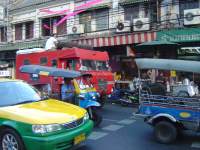 market). We sat in stationary traffic for an hour before we managed to struggle across the city. We were told to expect Moscow driving but were pleasantly surprised by the courteousness of the drivers who let us into the correct lane after we had to weave our way across the traffic to get to the exit.
market). We sat in stationary traffic for an hour before we managed to struggle across the city. We were told to expect Moscow driving but were pleasantly surprised by the courteousness of the drivers who let us into the correct lane after we had to weave our way across the traffic to get to the exit. 